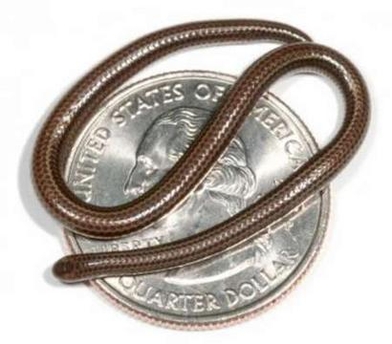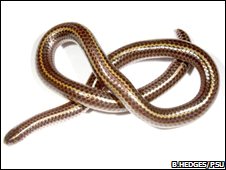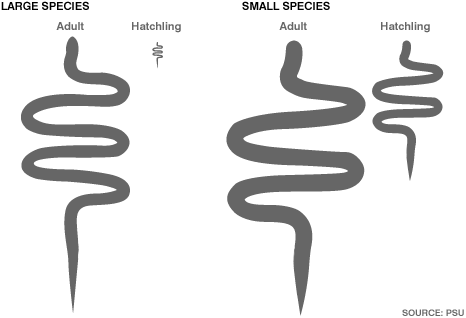Earth’s Smallest Snake Discovered on Barbados
Posted by: Loren Coleman on August 3rd, 2008

Images of the snake show it is small enough to curl up on a US quarter.
I was thrilled when I turned over that rock and found it. After finding the first one, we turned hundreds of other stones to find another one. Biologist Blair Hedges
The world’s smallest snake, averaging merely 4 inches (10 cm) and as thin as a spaghetti noodle, has been discovered on the Caribbean island of Barbados.
The snake, found beneath a rock in a tiny fragment of threatened forest, is thought to be at the very limit of how small a snake can evolve to be.
Females produce only a single, massive egg – and the young hatch at half of their adult body weight.
This new discovery is described in the journal of Zootaxa.
The snake – named Leptotyphlops carlae – is the smallest of the 3,100 known snake species and was uncovered by Dr. Blair Hedges, a biologist from Penn State University.
In total, Dr. Hedges and his herpetologist wife found only two females.
Dr. Hedges thinks that the snake eats termites and is endemic to this one Caribbean island. He said that, in fact, three very old specimens of this species were already in collections – one in London’s Natural History Museum and two in a museum in Martinique.
However, these specimens had been misidentified.

The snake’s habitat is usually under rocks eating termites.
Dr. Hedges explained the difficulty in defining a new species when the organism is so small.
Differences in small animals are much more subtle and so are frequently over-looked. The great thing is that DNA is as different between two small snakes as it is between two large snakes, allowing us to see the differences that we can’t see by eye,” ~ Dr. Hedges.
Researchers believe that the snake – a type of thread snake – is so rare that it has survived un-noticed until now.
But with 95% of the island of Barbados now treeless, and the few fragments of forest seriously threatened, this new species of snake might become extinct only months after it was discovered.
In contrast to other species of snake – some of which can lay up to 100 eggs in a single clutch – the world’s smallest snake only produces a single egg.
“This is unusual for snakes but seems to be a feature of small animals,” Dr Hedges told BBC News.
By having a single egg at a time, the snake’s young are one-half the length of the adult. That would be like humans giving birth to a 60-pound (27kg) baby
Dr Hedges added that the snake’s size might limit the size of its clutch.
“If a tiny snake were to have more than one offspring, each egg would have to share the same space occupied by the one egg and so the two hatchlings would be half the normal size.”
The hatchlings might then be too small to find anything small enough to eat.
This has led the researchers to believe that the Barbadian snake is as small as a snake can evolve to be.
The smallest animals have young that are proportionately enormous relative to the size of the adults producing the offspring
As in the case of Leptotyphlops carlae, the hatchlings of the smallest snakes are one-half the length of an adult
The hatchlings of the biggest snakes on the other hand are only one-tenth the length of the adult producing the offspring
Tiny snakes produce only one massive egg – relative to the size of the mother. This is evolution at work, says Dr Hedges
The pressure of natural selection means the size of hatchlings cannot be smaller than a critical limit if they are to survive
BBC’s Science Reporter Jennifer Carpenter’s article, “World’s smallest snake discovered” served as the basis for this report.

About Loren Coleman
Loren Coleman is one of the world’s leading cryptozoologists, some say “the” leading living cryptozoologist. Certainly, he is acknowledged as the current living American researcher and writer who has most popularized cryptozoology in the late 20th and early 21st centuries.
Starting his fieldwork and investigations in 1960, after traveling and trekking extensively in pursuit of cryptozoological mysteries, Coleman began writing to share his experiences in 1969. An honorary member of Ivan T. Sanderson’s Society for the Investigation of the Unexplained in the 1970s, Coleman has been bestowed with similar honorary memberships of the North Idaho College Cryptozoology Club in 1983, and in subsequent years, that of the British Columbia Scientific Cryptozoology Club, CryptoSafari International, and other international organizations. He was also a Life Member and Benefactor of the International Society of Cryptozoology (now-defunct).
Loren Coleman’s daily blog, as a member of the Cryptomundo Team, served as an ongoing avenue of communication for the ever-growing body of cryptozoo news from 2005 through 2013. He returned as an infrequent contributor beginning Halloween week of 2015.
Coleman is the founder in 2003, and current director of the International Cryptozoology Museum in Portland, Maine.










That is a small snake; I could see this being mistaken for a worm every time it was distantly sighted. Sort of brings to mind how many more species might be out there that simply haven’t been noticed. We do have a tendancy to assume the things we deal with are all known – encounters with large potential undiscoverds like Bigfoot can serve as a lesson that we know really a lot less than we like to think. Think how many species like this snake could fit in one Bigfoot; thousands, maybe hundreds of thousands… And this is just one little planet in practical infinity; and maybe this is even just one dimensional phase of infinity. Point in case, the tiniest discoveries can teach a lot about the largest possibilities. Weird to think how every time you set your foot down in the grass you could be wiping out the last of some never-before-seen species. It’s cool we can actually find and scientifically catagorize a few from time to time
Very interesting discovery. It’s nice to take a break from the big animal discoveries that usually take center stage and take a moment to appreciate the small ones. I don’t think the smaller animal discoveries get nearly as much coverage in the general public as they should. I guess it’s just not that surprising to people that something so small could remain hidden.
Still, very exciting find from an evolutionary point of view. The expression of giganticism as well as extreme dwarfism in certain species of animals and what specific evironmental conditions led to these adaptations are of great interest to me. Also, I’m happy to see attention drawn to the evolutionary development concerning size of offspring. Often when people look at the way animals have evolved, they tend to focus on the adaptations exhibited in adult animals without realizing that evolution expresses itself in the embryonic and immature stages as well. Good to see this addressed here. Fascinating stuff.
I sure hope that this unique species has a healthy population. Barbados is a small island and much of its land has been turned to sugarcane farms. If hundreds of rocks had to be lifted before a second specimen was found this could mean a big percent of the forest area. The government should be encouraged to make it their national animal so that its survival is guaranteed.
Really cool discovery!!! Awesome! I just hope they do something to protect and preserve the environment where the snake was discovered. Could be good for tourism as an added draw for visiting Barbados.
Every time I hear about snakes in a threatened area, I end up wishing the movie “Stanley” would come true – it was a “Willard” variation, about trained rattlesnakes killing poachers and polluters and so on. Maybe it’s a ruthless “eco-nazi” kind of wish, but I still indulge it.
The Brahminy blind snake (Ramphotyphlops braminus) is as small as or smaller than this newly discovered species. I know because I catch them regularly.
Maybe someone forgot to check the reference books with all this fanfare.
They are from overseas but came to the US and other parts of the world via potting soil in plants. I find them here in Miami often.
For more info check http://www.oplin.lib.oh.us/snake/fact%20pages/brahminy_blind/brahminy.html“>here and http://www.flmnh.ufl.edu/herpetology/fl-guide/Ramphotyphlopsbraminus.htm“>here.
Just wanted to mention that Mr. Coleman had this story up on this website about 24 hours before CNN mentioned it. Another feather in his (and members of the crypto crowd) cap.